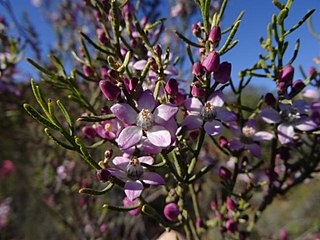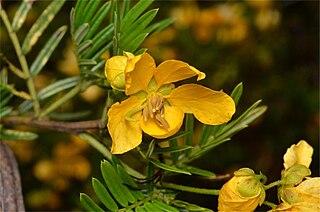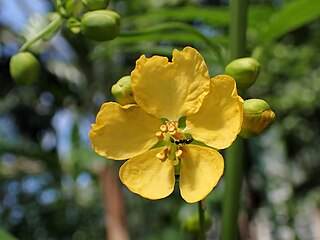
Senna, the sennas, is a large genus of flowering plants in the legume family. This diverse genus is native throughout the tropics, with a small number of species in temperate regions. The number of species is estimated to be from about 260 to 350. The type species for the genus is Senna alexandrina. About 50 species of Senna are known in cultivation.

Senna artemisioides, commonly known as silver cassia, is a species of flowering plant in the family Fabaceae and is endemic to Australia, where it is found in all mainland states and territories. It is a small, woody shrub with silver-green leaves and yellow flowers.

Pimelea microcephala, commonly known as mallee rice-flower or shrubby rice-flower is a species of flowering plant in the family Thymelaeaceae and is endemic to mainland Australia. It is an erect shrub with compact heads of male or female, white to yellow or greenish flowers on separate plants, the heads surrounded by 2 or 4 leaf-like involucral bracts.

Senna acclinis, commonly known as rainforest cassia or brush senna, is a species of flowering plant in the family Fabaceae and is endemic to near-coastal areas of eastern Australia. It is a shrub with pinnate leaves and bright golden yellow flowers in groups of two to five and long, narrow seed pods. It is similar to other species of Senna that are environmental weeds.

Isopogon divergens, commonly known as spreading coneflower, is a species of plant in the family Proteaceae and is endemic to the south-west of Western Australia. It is a shrub with pinnate leaves and more or less spherical heads of glabrous pink flowers followed by an oval to cylindrical fruiting cone.

Zanthoxylum rhetsa, commonly known as Indian prickly ash, is a species of flowering plant in the family Rutaceae and occurs from India east to the Philippines and south to northern Australia. It is a deciduous shrub or tree with cone-shaped spines on the stems, pinnate leaves with between nine and twenty-three leaflets, panicles of white or yellowish, male and female flowers, followed by spherical red, brown or black follicles.
Thryptomene eremaea is a species of flowering plant in the family Myrtaceae and is endemic to Western Australia. It is an erect shrub with upward-pointing, oval leaves and white or pale pink flowers with five petals and ten irregularly arranged stamens.

Philotheca brucei is a species of flowering plant in the family Rutaceae and is endemic to Western Australia. It is a shrub with cylindrical leaves grooved along the top and in spring, white to pink or mauve flowers with five egg-shaped petals.

Boronia tolerans is a plant in the citrus family, Rutaceae and is endemic to a small area in the Northern Territory in Australia. It is an erect shrub with many branches, pinnate leaves and white, four-petalled flowers. It is only known from Nitmiluk National Park.

Senna pendula, also known as Easter Cassia, Christmas Senna, winter Senna, climbing Cassia, golden shower, pendant Senna and valamuerto, is a plant of the Fabaceae family with a shrub habit that is native to South America. It used in various parts of the world as an ornamental plant and is an environmental weed in Australia. The flowers are yellow and the name pendula means 'pendulous' or 'drooping'.

Hibbertia desmophylla is a species of flowering plant in the family Dilleniaceae and is endemic to the south-west of Western Australia. It is a sprawling or erect, hairy shrub with spreading, densely clustered, linear leaves and yellow flowers with eleven to thirteen stamens.
Pimelea holroydii is a species of flowering plant in the family Thymelaeaceae and is endemic to the north of Western Australia. It is an erect shrub with egg-shaped leaves arranged more or less in opposite pairs, and head-like clusters of white or cream-coloured, tube-shaped flowers.

Pimelea spiculigera is a species of flowering plant in the family Thymelaeaceae and is endemic to Western Australia. It is an erect shrub with linear to narrowly egg-shaped leaves and heads of yellow or greenish-yellow flowers surrounded by 2 or 4 egg-shaped involucral bracts.
Androcalva microphylla is a species of flowering plant in the family Malvaceae and is endemic to the south-west of Western Australia. It is an open, straggling shrub with egg-shaped to oblong leaves with a heart-shaped base, and clusters of 5 to 7 white and dark red flowers.

Senna aciphylla, commonly known as sprawling senna or Australian senna, is a species of flowering plant in the family Fabaceae and is endemic to eastern Australia. It is a sprawling shrub with pinnate leaves with eight to twelve pairs of linear to narrowly elliptic leaflets, and yellow flowers in pairs or groups of three.

Senna barclayana, commonly known as smooth senna or pepper-leaf senna, is a species of flowering plant in the family Fabaceae and is endemic to eastern Australia. It is a herbaceous perennial or subshrub with pinnate leaves with six to ten pairs of lance-shaped or narrowly elliptic leaflets, and yellow flowers in groups of six to ten.

Senna barronfieldii, commonly known as southern cassia, is a species of flowering plant in the family Fabaceae and is endemic to eastern Australia. It is an erect shrub with more or less glabrous, pinnate leaves with eight to thirteen pairs of lance-shaped or elliptic leaflets, and yellow flowers in groups of three to five.

Senna cardiosperma is a species of flowering plant in the family Fabaceae and is endemic to the western half of Australia. It is an erect shrub or small tree with pinnate leaves, the number and shape of the leaflets depending on subspecies, yellow flowers with ten fertile stamens in each flower, and flat pods.

Senna circinnata, commonly known as coiled cassia, is a species of flowering plant in the family Fabaceae and is endemic to eastern Australia. It is a shrub or small tree with pinnate leaves with one to three pairs of egg-shaped leaflets, and small groups of yellow flowers in upper leaf axils.
Senna cladophylla is a species of flowering plant in the family Fabaceae and native to Western Australia and the Northern Territory. It is a perennial herb or undershrub with pinnate leaves with two or three pairs of broadly elliptic leaflets, and yellow flowers arranged in pairs, with ten fertile stamens in each flower.
















